Abstract
An aminoglycoside antibiotic and carbenicillin or ticarcillin are widely used in the treatment of patients with gram-negative bacillus infections. This study evaluated the effect of time upon in vitro interaction between mixtures of four aminoglycosides at two concentrations with carbenicillin or ticarcillin at four concentrations. By linear regression analysis, the inactivation of each aminoglycoside was shown to be directly proportional to the concentration of carbenicillin (P < 0.001). Inactivation was significantly (P < 0.01) greater for gentamicin and tobramycin than for amikacin or netilmicin at all carbenicillin concentrations. At carbenicillin concentrations of 300 and 600 μg/ml, significantly (P < 0.005) less inactivation of amikacin occurred when compared to netilmicin. Ticarcillin produced a significant (P < 0.025) inactivation of gentamicin and tobramycin, with inactivation being directly proportional to ticarcillin concentration. No inactivation of amikacin or netilmicin activity occurred unless the ticarcillin concentration was 600 μg/ml. No significant change in aminoglycoside activity occurred when stored with ticarcillin or carbenicillin at concentrations ranging from 100 to 600 μg/ml at −70°C for 56 days. When an aminoglycoside and carbenicillin or ticarcillin are indicated in patients with renal failure, this study supports the use of ticarcillin with either amikacin or netilmicin.
Full text
PDF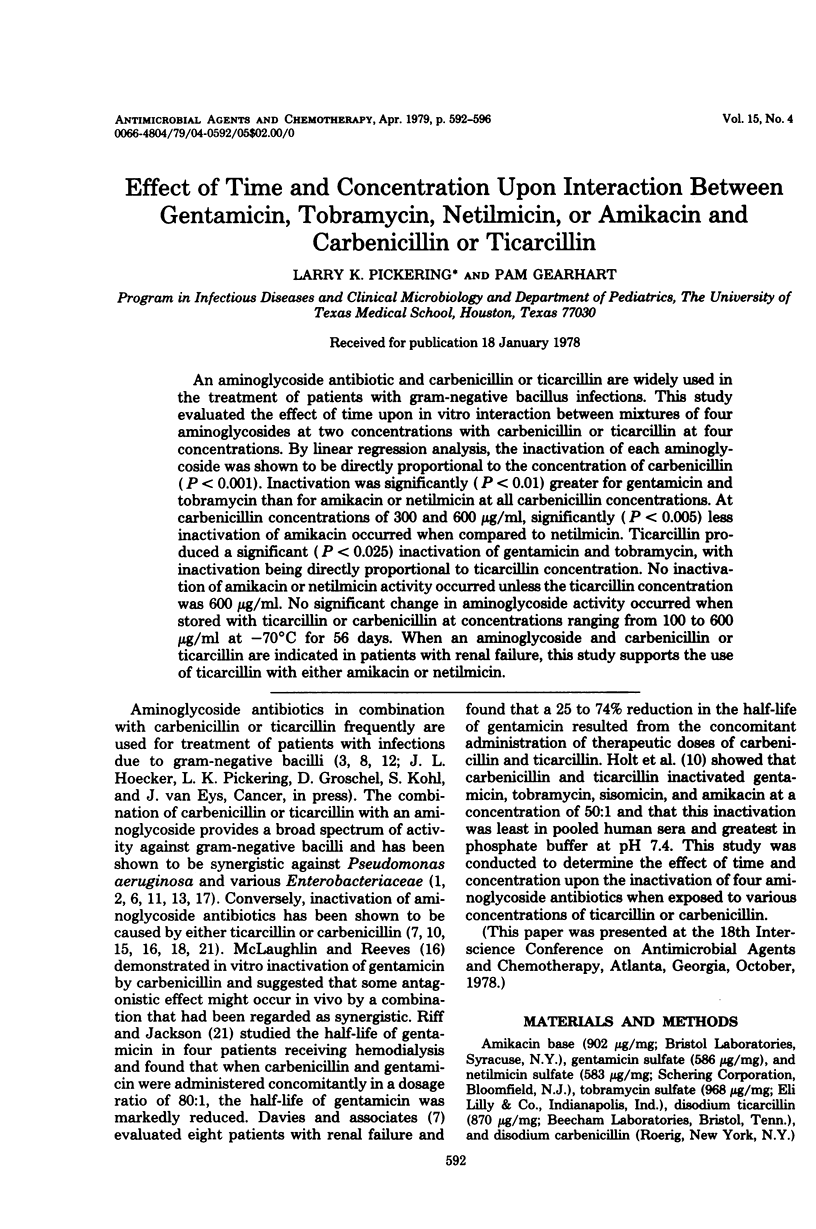
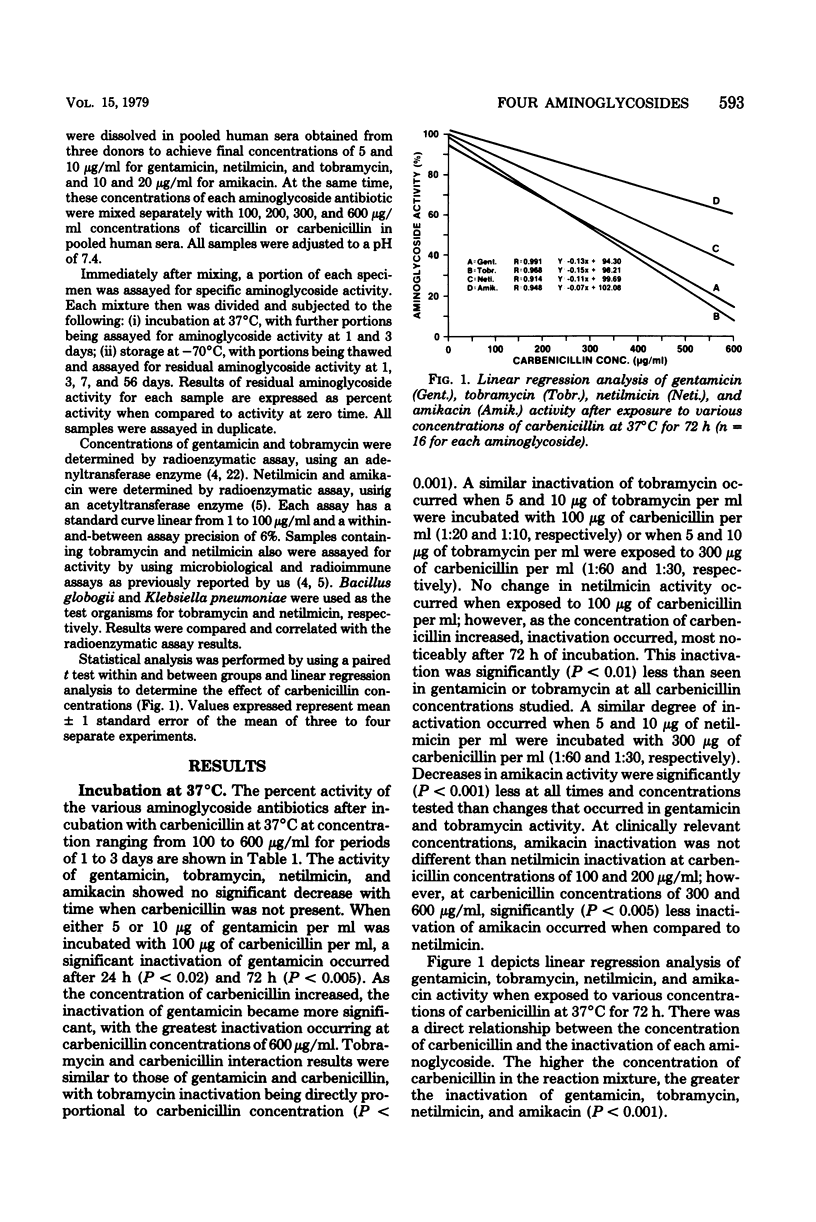
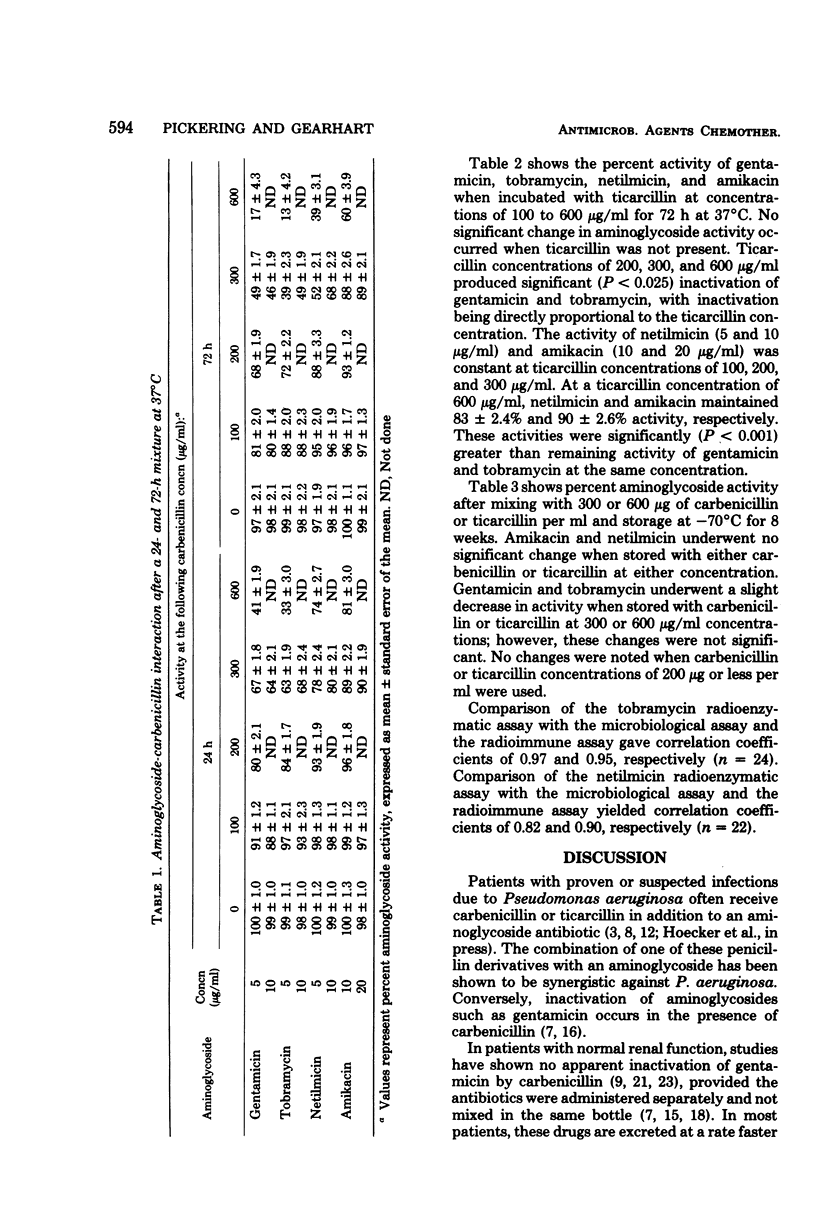
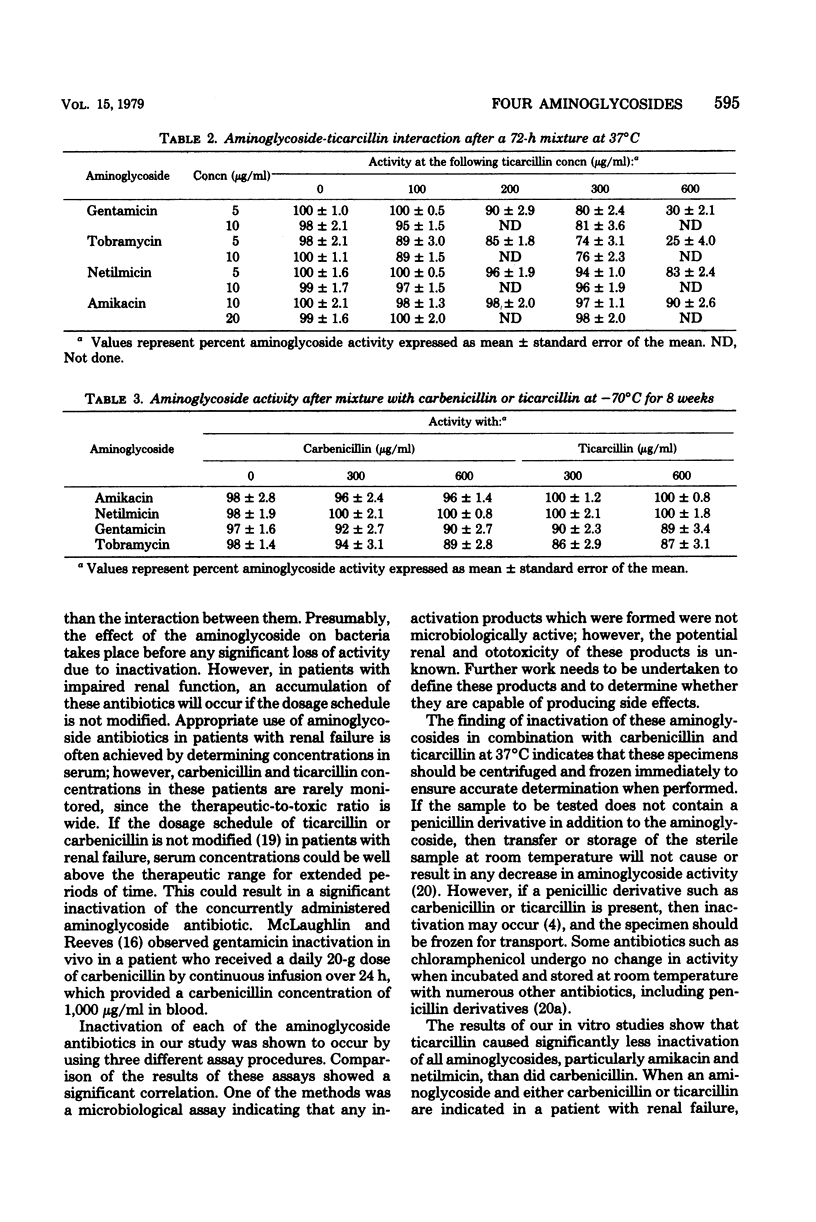
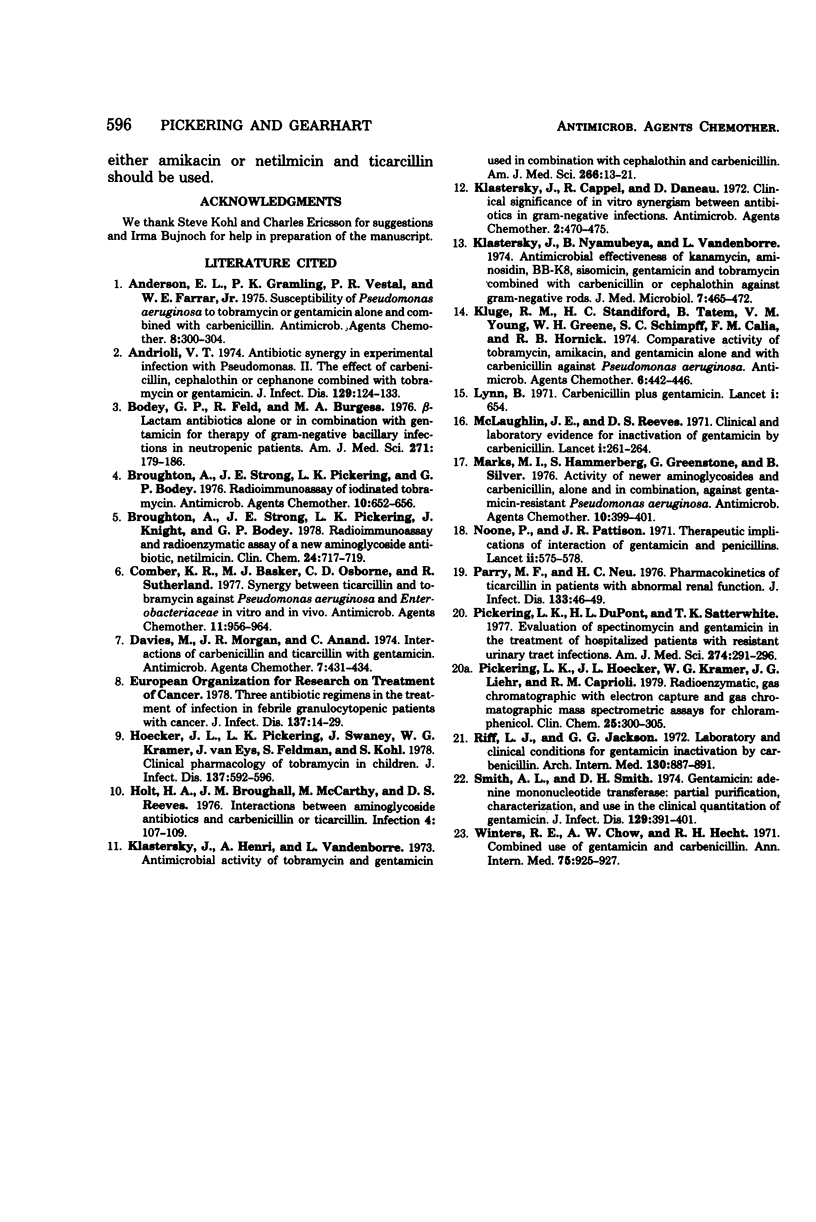
Selected References
These references are in PubMed. This may not be the complete list of references from this article.
- Anderson E. L., Gramling P. K., Vestal P. R., Farrar W. E., Jr Susceptibility of Pseudomonas aeruginosa to tobramycin or gentamicin alone and combined with carbenicillin. Antimicrob Agents Chemother. 1975 Sep;8(3):300–304. doi: 10.1128/aac.8.3.300. [DOI] [PMC free article] [PubMed] [Google Scholar]
- Andriole V. T. Antibiotic synergy in experimental infection with Pseudomonas. II. The effect of carbenicillin, cephalothin, or cephanone combined with tobramycin or gentamicin. J Infect Dis. 1974 Feb;129(2):124–133. doi: 10.1093/infdis/129.2.124. [DOI] [PubMed] [Google Scholar]
- Bodey G. P., Feld R., Burgess M. A. Beta-lactam antibiotics alone or in combination with gentamicin for therapy of gram-negative bacillary infections in neutropenic patients. Am J Med Sci. 1976 Mar-Apr;271(2):179–186. doi: 10.1097/00000441-197603000-00006. [DOI] [PubMed] [Google Scholar]
- Broughton A., Strong J. E., Pickering L. K., Bodney G. P. Radioimmunoassay of iodinated tobramycin. Antimicrob Agents Chemother. 1976 Oct;10(4):652–656. doi: 10.1128/aac.10.4.652. [DOI] [PMC free article] [PubMed] [Google Scholar]
- Broughton A., Strong J. E., Pickering L. K., Knight J., Bodey G. P. Radioimmunoassay and radioenzymatic assay of a new aminoglycoside antibiotic, netilmicin. Clin Chem. 1978 Apr;24(4):717–719. [PubMed] [Google Scholar]
- Comber K. R., Basker M. J., Osborne C. D., Sutherland R. Synergy between ticarcillin and tobramycin against Pseudomonas aeruginosa and Enterobacteriaceae in vitro and in vivo. Antimicrob Agents Chemother. 1977 Jun;11(6):956–964. doi: 10.1128/aac.11.6.956. [DOI] [PMC free article] [PubMed] [Google Scholar]
- Davies M., Morgan J. R., Anand C. Interactions of carbenicillin and ticarcillin with gentamicin. Antimicrob Agents Chemother. 1975 Apr;7(4):431–434. doi: 10.1128/aac.7.4.431. [DOI] [PMC free article] [PubMed] [Google Scholar]
- Hoecker J. L., Pickering L. K., Swaney J., Kramer W. G., van Eys J., Feldman S., Kohl S. Clinical pharmacology of tobramycin in children. J Infect Dis. 1978 May;137(5):592–596. doi: 10.1093/infdis/137.5.592. [DOI] [PubMed] [Google Scholar]
- Holt H. A., Broughall J. M., McCarthy M., Reeves D. S. Interactions between aminoglycoside antibiotics and carbenicillin or ticarillin. Infection. 1976;4(2):107–109. doi: 10.1007/BF01638726. [DOI] [PubMed] [Google Scholar]
- Klastersky J., Cappel R., Daneau D. Clinical significance of in vitro synergism between antibiotics in gram-negative infections. Antimicrob Agents Chemother. 1972 Dec;2(6):470–475. doi: 10.1128/aac.2.6.470. [DOI] [PMC free article] [PubMed] [Google Scholar]
- Klastersky J., Henri A., Vandenborre L. Antimicrobial activity of tobramycin and gentamicin used in combination with cephalothin and carbenicillin. Am J Med Sci. 1973 Jul;266(1):13–21. doi: 10.1097/00000441-197307000-00002. [DOI] [PubMed] [Google Scholar]
- Klastersky J., Lynn B. Carbenicillin plus gentamicin. Lancet. 1971 Mar 27;1(7700):653–654. doi: 10.1016/s0140-6736(71)91592-3. [DOI] [PubMed] [Google Scholar]
- Klastersky J., Nyamubeya B., Vandenborre L. Antimicrobial effectiveness ofkanamycin, aminosidin, BB-K8, sisomicin, gentamicin and tobramycin combined with carbenicillin or cephalothin against gram-negative rods. J Med Microbiol. 1974 Nov;7(4):465–472. doi: 10.1099/00222615-7-4-465. [DOI] [PubMed] [Google Scholar]
- Kluge R. M., Standiford H. C., Tatem B., Young V. M., Greene W. H., Schimpff S. C., Calia F. M., Hornick R. B. Comparative activity of tobramycin, amikacin, and gentamicin alone and with carbenicillin against Pseudomonas aeruginosa. Antimicrob Agents Chemother. 1974 Oct;6(4):442–446. doi: 10.1128/aac.6.4.442. [DOI] [PMC free article] [PubMed] [Google Scholar]
- Marks M. I., Hammerberg S., Greenstone G., Silver B. Activity of newer aminoglycosides and carbenicillin, alone and in combination, against gentamicin-resistant Pseudomonas aeruginosa. Antimicrob Agents Chemother. 1976 Sep;10(3):399–401. doi: 10.1128/aac.10.3.399. [DOI] [PMC free article] [PubMed] [Google Scholar]
- McLaughlin J. E., Reeves D. S. Clinical and laboratory evidence for inactivation of gentamicin by carbenicillin. Lancet. 1971 Feb 6;1(7693):261–264. doi: 10.1016/s0140-6736(71)91001-4. [DOI] [PubMed] [Google Scholar]
- Noone P., Pattison J. R. Therapeutic implications of interaction of gentamicin and penicillins. Lancet. 1971 Sep 11;2(7724):575–578. doi: 10.1016/s0140-6736(71)92152-0. [DOI] [PubMed] [Google Scholar]
- Parry M. F., Neu H. C. Pharmacokinetics of ticarcillin in patients with abnormal renal function. J Infect Dis. 1976 Jan;133(1):46–49. doi: 10.1093/infdis/133.1.46. [DOI] [PubMed] [Google Scholar]
- Pickering L. K., DuPont H. L., Satterwhite T. K. Evaluation of spectinomycin and gentamicin in the treatment of hospitalized patients with resistant urinary tract infections. Am J Med Sci. 1977 Nov-Dec;274(3):291–296. doi: 10.1097/00000441-197711000-00007. [DOI] [PubMed] [Google Scholar]
- Pickering L. K., Hoecker J. L., Kramer W. G., Liehr J. G., Caprioli R. M. Assays for chloramphenicol compared: radioenzymatic, gas chromatographic with electron capture, and gas chromatographic-mass spectrometric. Clin Chem. 1979 Feb;25(2):300–305. [PubMed] [Google Scholar]
- Riff L. J., Jackson G. G. Laboratory and clinical conditions for gentamicin inactivation by carbenicillin. Arch Intern Med. 1972 Dec;130(6):887–891. [PubMed] [Google Scholar]
- Smith A. L., Smith D. H. Gentamicin:adenine mononucleotide transferase: partial purification, characterization, and use in the clinical quantitation of gentamicin. J Infect Dis. 1974 Apr;129(4):391–401. doi: 10.1093/infdis/129.4.391. [DOI] [PubMed] [Google Scholar]
- Winters R. E., Chow A. W., Hecht R. H., Hewitt W. L. Combined use of gentamicin and carbenicillin. Ann Intern Med. 1971 Dec;75(6):925–927. doi: 10.7326/0003-4819-75-6-925. [DOI] [PubMed] [Google Scholar]


